Special Report
This Country Has the World’s Largest Military

Published:
Last Updated:

Ongoing conflicts in the Middle East and Africa, cartel violence in Central and South America, and simmering tensions in the South China Sea belie the fact that we are living through one of the most peaceful periods in human history, at least when considering deaths in violent conflicts. One school of thought claims that our relative peace is not only the product of a network of international alliances and agreements, but also of military power and capability that deters overt acts of aggression between nations.
There are an estimated 27.5 million military and paramilitary personnel across the globe. While the world has come a long way since the Cold War, when geopolitics was largely defined by two polar superpowers, military strength, arms and personnel, is still concentrated in a small number of countries. About half of all active-duty servicemen and servicewomen worldwide are in just 10 countries.
Using armed forces personnel data from the World Bank, 24/7 Wall St. identified the countries with the world’s largest militaries. Personnel counts include active-duty military personnel as well as paramilitary personnel and are from 2018, the most recent year of available data. Only paramilitary personnel whose training, organization, and equipment suggest they could be used alongside — or in lieu of — a more traditional military were included. Their inclusion means that personnel estimates may differ from other published estimates.
While maintaining a large standing army is a national security priority for each of the countries on this list, including the United States, it is perhaps less important now than it has been in years past. Advanced military technology, including drones and intercontinental ballistic missiles, now serves many of the same functions as raw human power. There are now nearly 1 million fewer Americans serving in the military than there were at the end of the Cold War. Here is a look at 19 commercial products invented by the military.
While militaries may be shrinking in size in much of the world, military budgets are not. Global military spending nearly topped $2 trillion in 2020, the highest level in over three decades. Only four countries on this list had a smaller military budget in 2020 than they did in 2011. Here is a look at the countries spending the most on war.
Click here to see the country with the world’s largest military.
To determine the countries with the largest militaries, 24/7 Wall St. reviewed World Bank data on military personnel from 2018, the most recent year of available data. Personnel counts include active-duty military personnel as well as paramilitary personnel.
Annual military expenditure in current U.S. dollars in 2020 are from the Stockholm International Peace Research Institute. Military expenditure covers the expenditures of current military forces and activities, including salaries and benefits, operational expenses, arms and equipment purchases, military construction, research and development, central administration, command, and support. Supplemental data on military expenditure in 2011, military expenditure adjusted for inflation, military expenditure as a percentage of GDP, and military expenditure per capita also came from SIPRI. Population data for 2019 came from the World Bank.
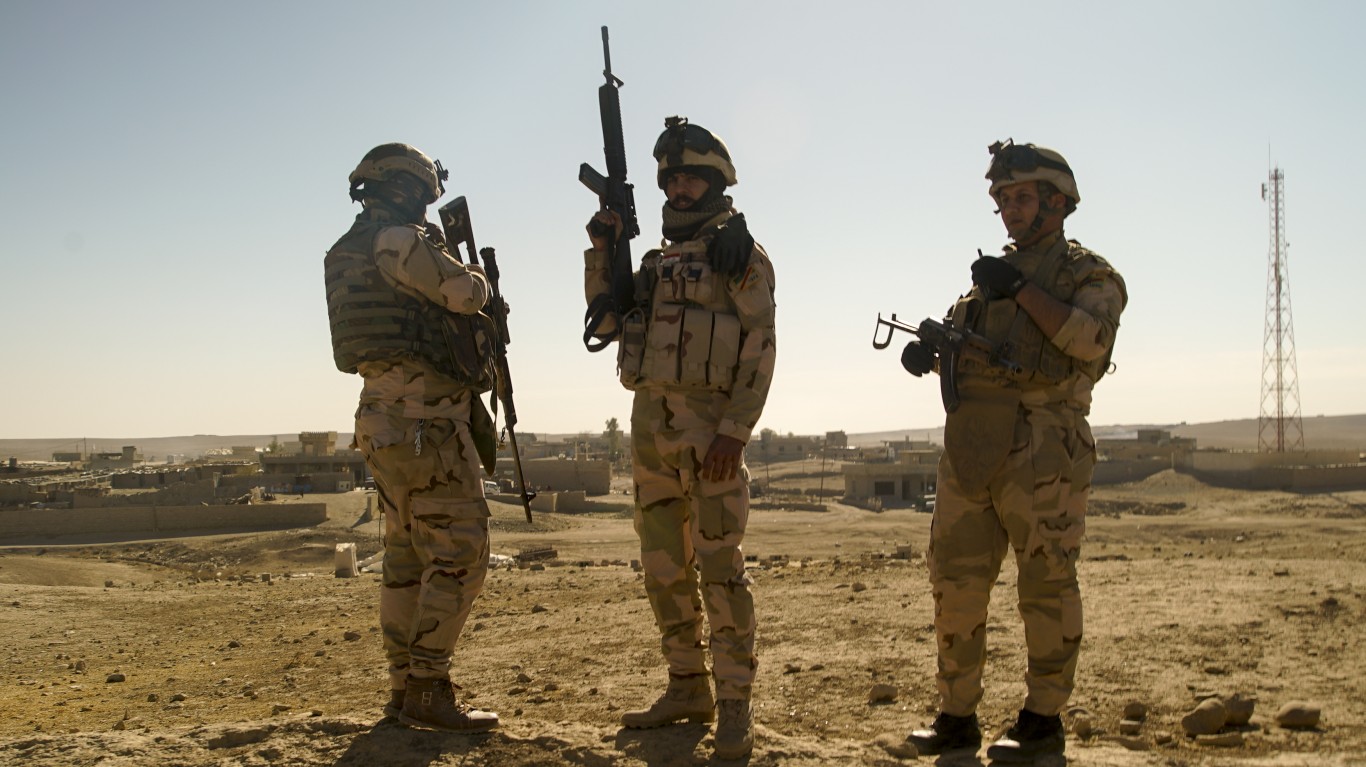
20. Iraq
> Military and paramilitary personnel: 336,000
> Military spending, 2020: $7.0 billion (4.1% of GDP)
> Change in military spending, 2011-2020: +64.0%
> Population: 39,309,783
Iraq has one of the world’s largest armed forces, with 336,000 military and paramilitary personnel, as of 2018. U.S. and coalition forces invaded Iraq in 2003 and occupied the country until 2011. As American troops pulled out of the country, Iraq’s military spending has grown considerably, increasing by 64% from 2011 to 2020 as it was fighting against Islamic State forces mostly in northern Iraq.
Iraq’s armed forces include active-duty personnel serving in the army, navy, air force, and Counterterrorism Service, as well as over 100,000 Popular Mobilization Forces. In addition to the official Iraqi military, the over 150,000 Kurdish Peshmerga forces are recognized as a legitimate military force by Iraq’s constitution. These forces often work with Iraq’s military on counterinsurgency missions, but operate outside the nation’s official military structure.
[in-text-ad]

19. Italy
> Military and paramilitary personnel: 341,500
> Military spending, 2020: $28.9 billion (1.6% of GDP)
> Change in military spending, 2011-2020: -14.5%
> Population: 60,297,396
Even as overall military expenditure across all countries for which there is data increased by 9.3% over the last nine years, Italy has sharply curtailed its military spending over that same period, with expenditure declining by 14.5% from 2011 to 2020. Even with this decline, the European country spent nearly $29 billion on its military in 2020, a higher total than all but 10 other countries in the world.
Italy’s military personnel serve in the army, navy, air force, and the Carabinieri — a branch of the armed forces that function similarly to police, investigating crimes, particularly organized crime, and apprehending suspects. There are around 5,000 Italian troops deployed around the world, many through NATO missions in the Middle East and several African countries.
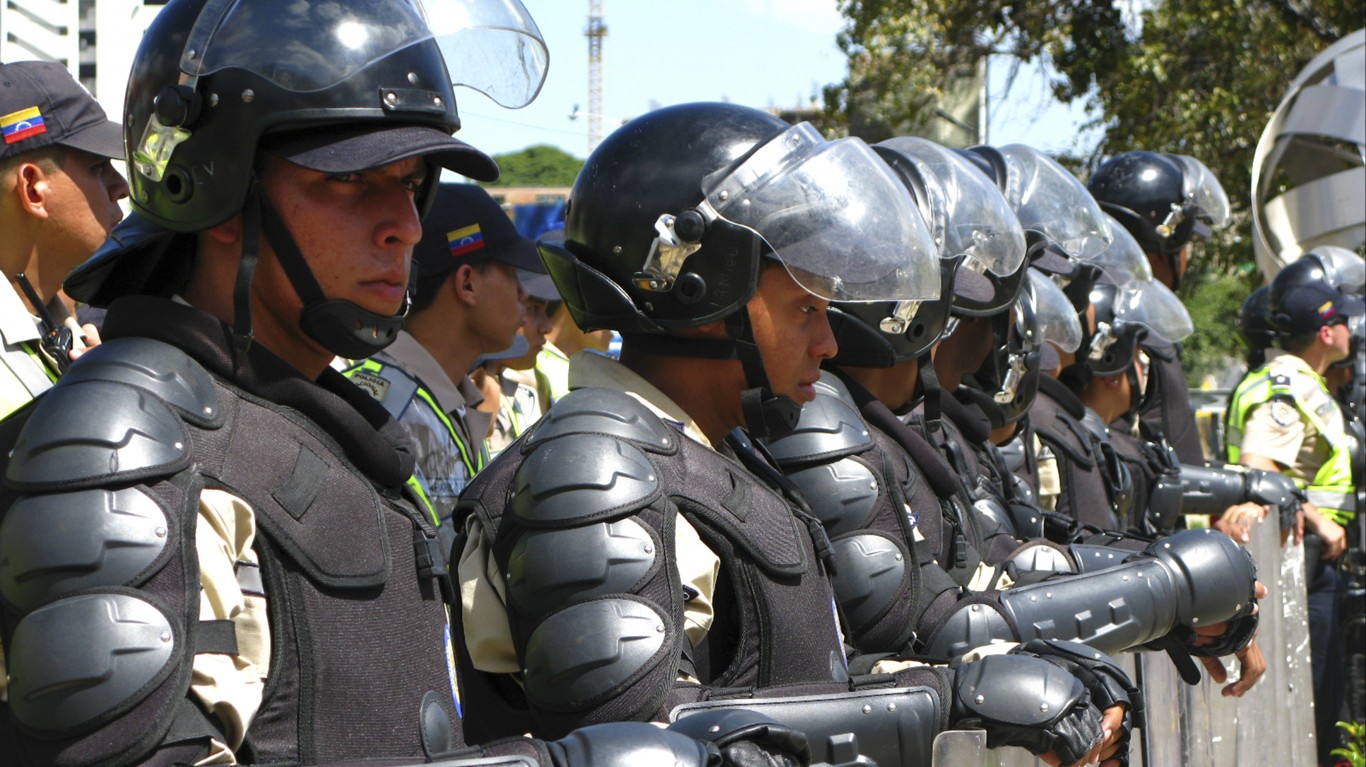
18. Venezuela
> Military and paramilitary personnel: 343,000
> Military spending, 2020: N/A
> Change in military spending, 2011-2020: N/A
> Population: 28,515,829
Of the countries with the largest militaries, a much higher share of Venezuelans serve in their nation’s military. The country’s 343,000 troops account for 1.2% of its 28.5 million population. This is the second largest share among the 20 countries with the largest militaries in the world.
Following a period of economic and political turmoil, strongman Hugo Chavez managed to seize power in 1999 and held the country — and the military — in his grips until his death in 2013. Since then, Nicolas Maduro has been president, until the 2018 presidential crisis, when Juan Guaido challenged the results and had the support of several nations worldwide. Despite the political challenges as well as others like food shortages and hyperinflation, the military has

17. Mexico
> Military and paramilitary personnel: 348,000
> Military spending, 2020: $6.1 billion (0.6% of GDP)
> Change in military spending, 2011-2020: +11.2%
> Population: 127,575,529
Even though Mexico has one of the largest militaries in the world, with nearly 350,000 personnel, it spends a relatively low share of its GDP maintaining its armed forces. The North American country spent $6.1 billion, or 0.6% of its GDP, on its military. This is the lowest share of any nation with one of the 20 largest militaries. Only one other country on this list spent less than 1% of its GDP on its military in 2020.
The Mexican military is composed mostly of army, navy, and air force troops. The country also formed a National Guard in 2019 that now has around 100,000 national guard members. In recent years, the Mexican military has worked domestically to combat organized crime groups like drug cartels.
[in-text-ad-2]
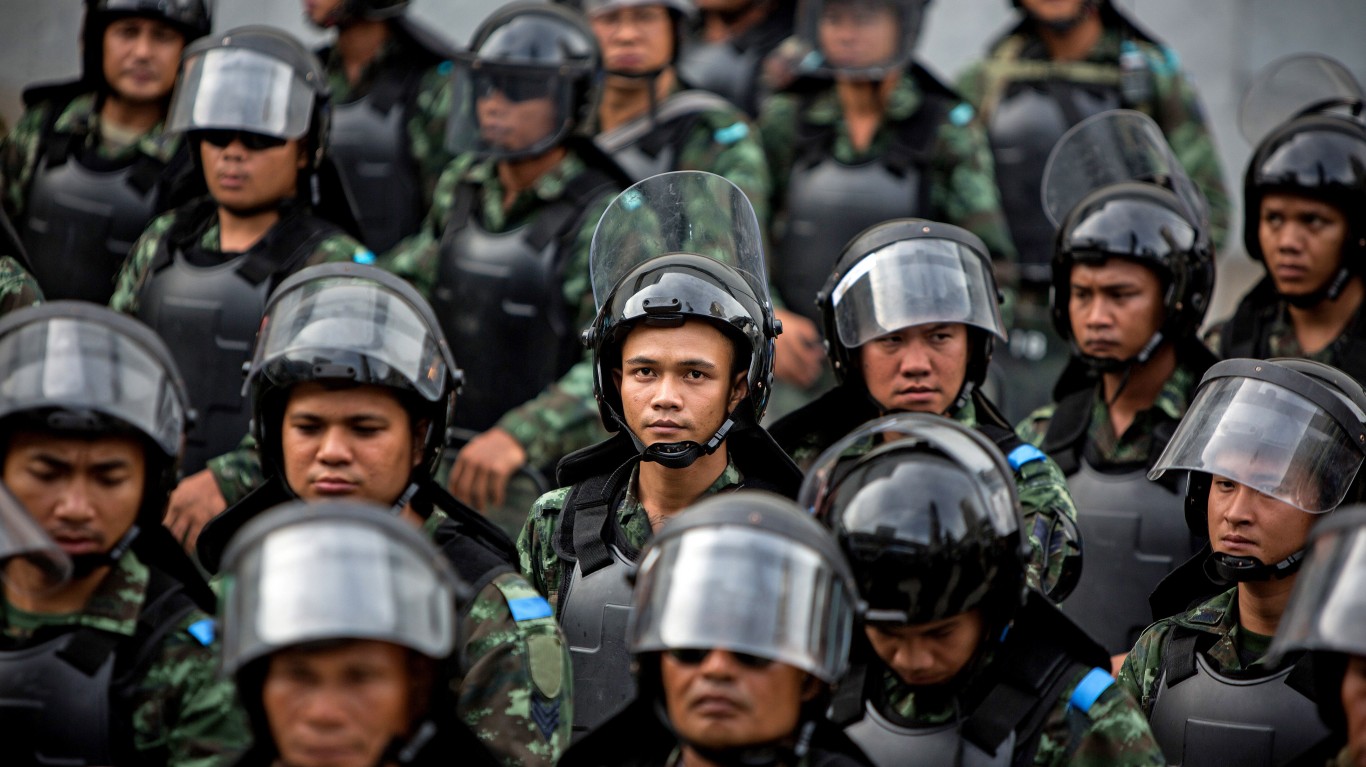
16. Thailand
> Military and paramilitary personnel: 454,850
> Military spending, 2020: $7.3 billion (1.5% of GDP)
> Change in military spending, 2011-2020: +33.1%
> Population: 69,625,582
Thailand’s military spending has surged significantly in the last decade, growing by more than 33% from 2011 to 2020 to $7.3 billion. This spending supports the nearly 455,000 military personnel in the country. The Thai military comprises the Royal Thai Armed Forces, Thai Rangers, and Internal Security Operations Command.
The Thai military has largely combated separatist forces in recent years from Malay nationalist groups. The country has a compulsory two-year military service, decided by lottery, for males ages 21 and older, though those 18 and older can volunteer for service.

15. Colombia
> Military and paramilitary personnel: 481,200
> Military spending, 2020: $9.2 billion (3.4% of GDP)
> Change in military spending, 2011-2020: -10.6%
> Population: 50,339,443
In addition to having one of the 20 largest militaries, Colombia also ranks among the top 20 nations in the world in terms of military spending as a percentage of its GDP. The South American country spent $9.2 billion, or 3.4% of its GDP, on its military in 2020 — the 19th highest share among all nations. Though this is a large share, Colombia’s military spending has declined sharply in recent years, down 10.6% from 2011 to 2020.
Colombia’s military has over 480,000 servicemen and servicewomen, as those ages 18-24 are subject to compulsory conscription for 18 months. The military in Colombia primarily focuses on security challenges from its neighbor to the east, Venezuela, as well as insurgent groups. Though Colombia’s government ended a decades-long conflict with insurgent group FARC in 2016, similar guerrilla organizations have splintered off and resumed armed insurgency.
[in-text-ad]
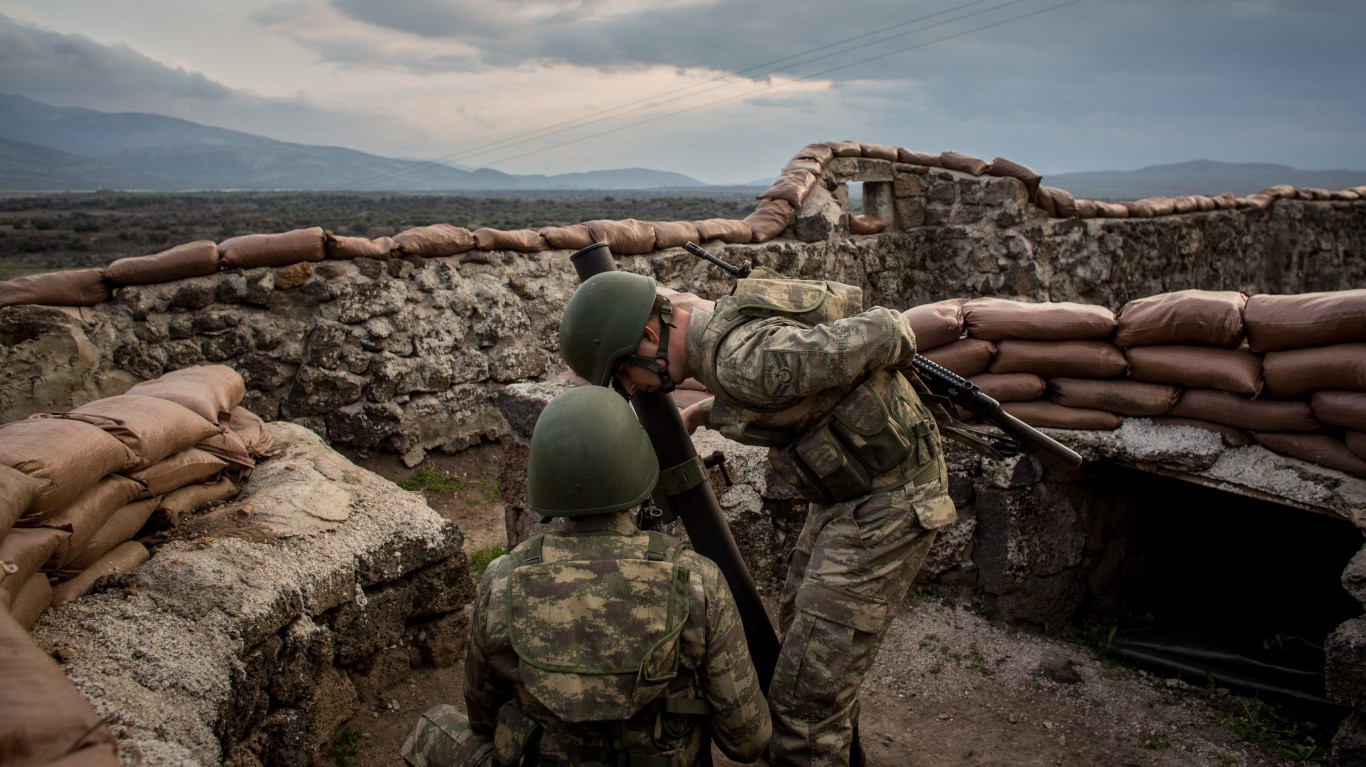
14. Turkey
> Military and paramilitary personnel: 512,200
> Military spending, 2020: $17.7 billion (2.8% of GDP)
> Change in military spending, 2011-2020: +4.2%
> Population: 83,429,615
Turkey is one of 14 countries in the world with more than half a million total military personnel, according to 2018 figures. The country’s military spending is similarly high, with its $17.7 billion expenditure ranking 17th in the world in 2020. In 2016, some of Turkey’s military launched an unsuccessful coup attempt against President Recep Tayyip Erdogan. The coup failed as it did not receive broad civilian or military support.
Around 400,000 of the over 500,000 Turkish military troops serve in the Turkish Armed Forces, with the rest serving as gendarmerie, which operates as law enforcement in the country. In recent years, Turkey has deployed some of its armed forces to Syria, Libya, Afghanistan, and Iraq to fight various militant groups.
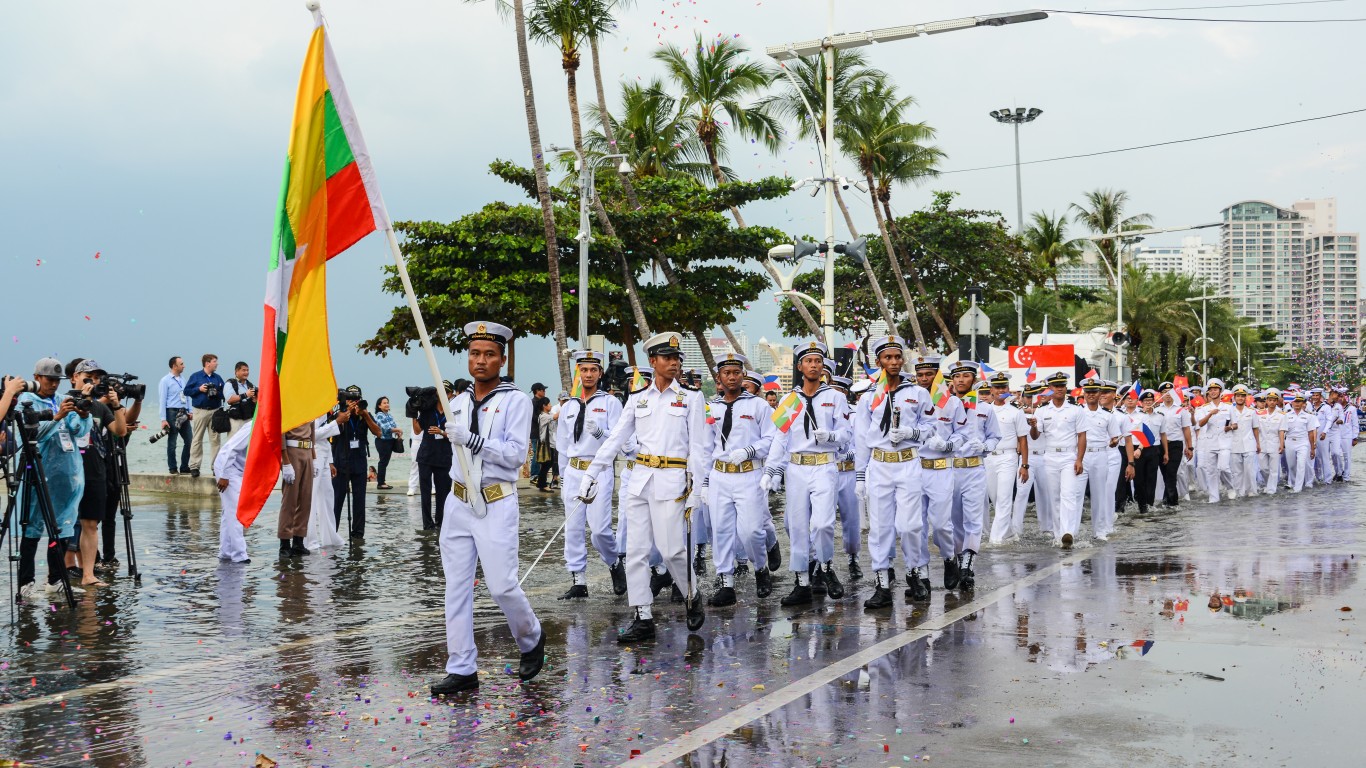
13. Myanmar
> Military and paramilitary personnel: 513,000
> Military spending, 2020: $2.4 billion (2.9% of GDP)
> Change in military spending, 2011-2020: N/A
> Population: 54,045,420
Beginning in February 2021, Myanmar’s military launched a coup against the nation’s elected leadership, detaining high-level elected political leaders. Before 2011, the country had been ruled by a dictatorial military junta for decades. In the months since the coup, more than 800 people have been killed by the military, and more than 4,000 have been detained.
As a country that had been ruled by its military for nearly 50 years, Myanmar is one of the most heavily militarized countries in the world. The country of 54 million has over 500,000 armed forces personnel. Myanmar spends 2.9% of its GDP on its military, more than all but 25 other countries in the world.
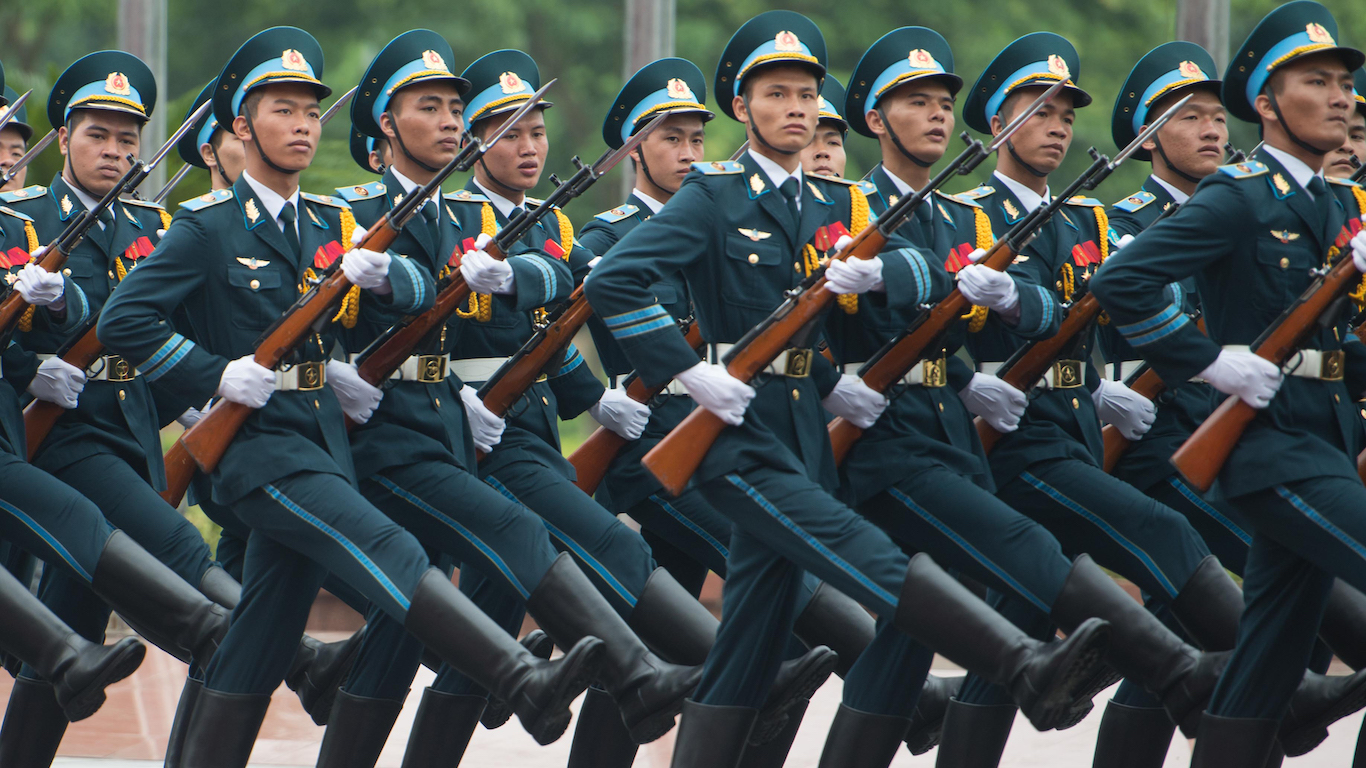
12. Vietnam
> Military and paramilitary personnel: 522,000
> Military spending, 2020: N/A
> Change in military spending, 2011-2020: N/A
> Population: 96,462,106
There are just over half a million active-duty military and paramilitary personnel in Vietnam — or 5.4 for every 1,000 citizens. For context, there are 4.2 active-duty military personnel for every 1,000 citizens in the United States. These servicemen and servicewomen are enlisted under the People’s Army of Vietnam, the Border Defense Force, and the Coast Guard. The country is one of several Southeast Asian nations to rank on this list.
The U.S. waged a costly and ultimately futile war against communist forces in northern Vietnam in the 1960s and ’70s. Following the U.S. withdrawal in 1973, Vietnam unified under a communist government. The two nations restored full diplomatic relations in 1995.
[in-text-ad-2]
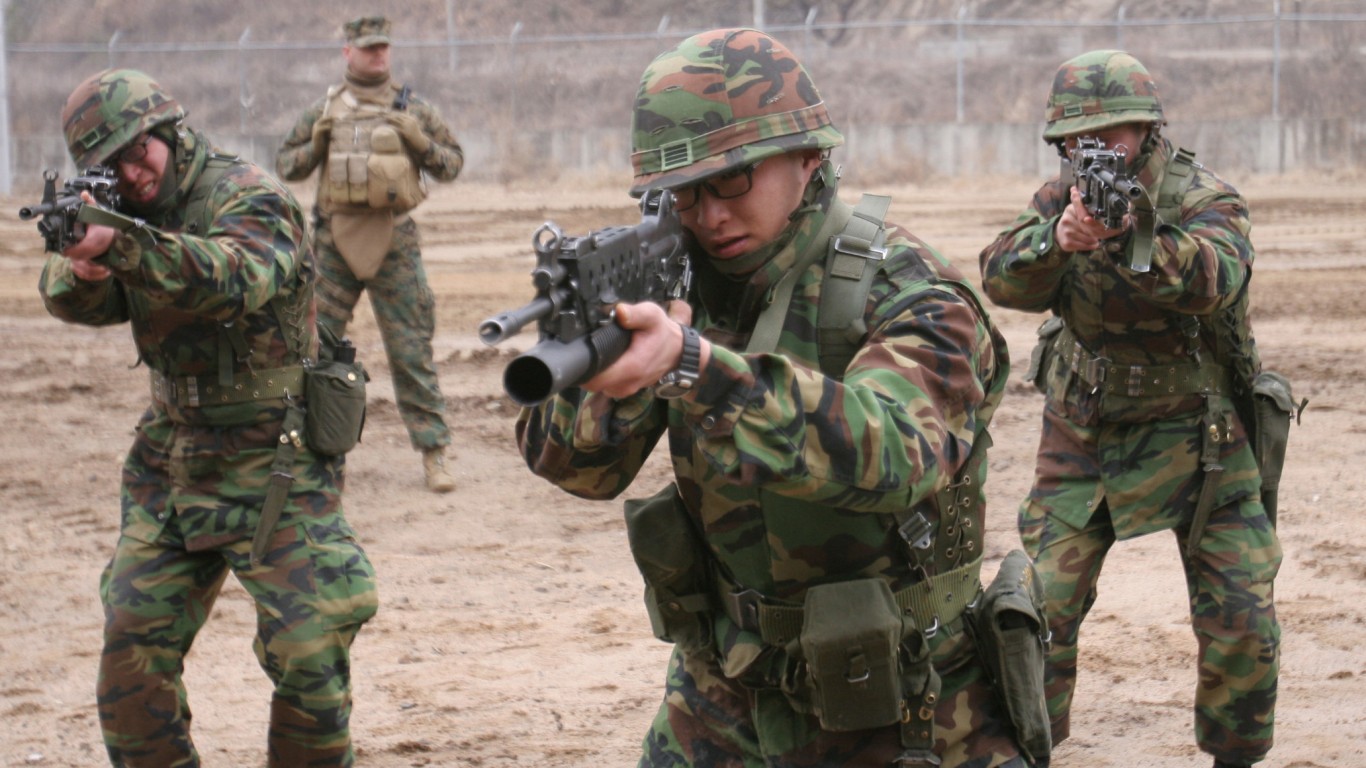
11. South Korea
> Military and paramilitary personnel: 608,000
> Military spending, 2020: $45.7 billion (2.8% of GDP)
> Change in military spending, 2011-2020: +47.6%
> Population: 51,709,098
South Korea’s military has about 608,000personnel, or 11.8 for every 1,000 citizens — a far larger ratio than most other nations with large militaries. Defense spending is also relatively high in South Korea. The country reported $45.7 billion in defense spending in 2020, a nearly 50% increase from 2011 and equal to 2.8% of its GDP.
South Korea prioritises military spending partially because the country has been at war with its totalitarian, nuclear armed neighbor, North Korea, since 1953. The United States, a close ally of South Korea, also has tens of thousands of troops stationed in the country.
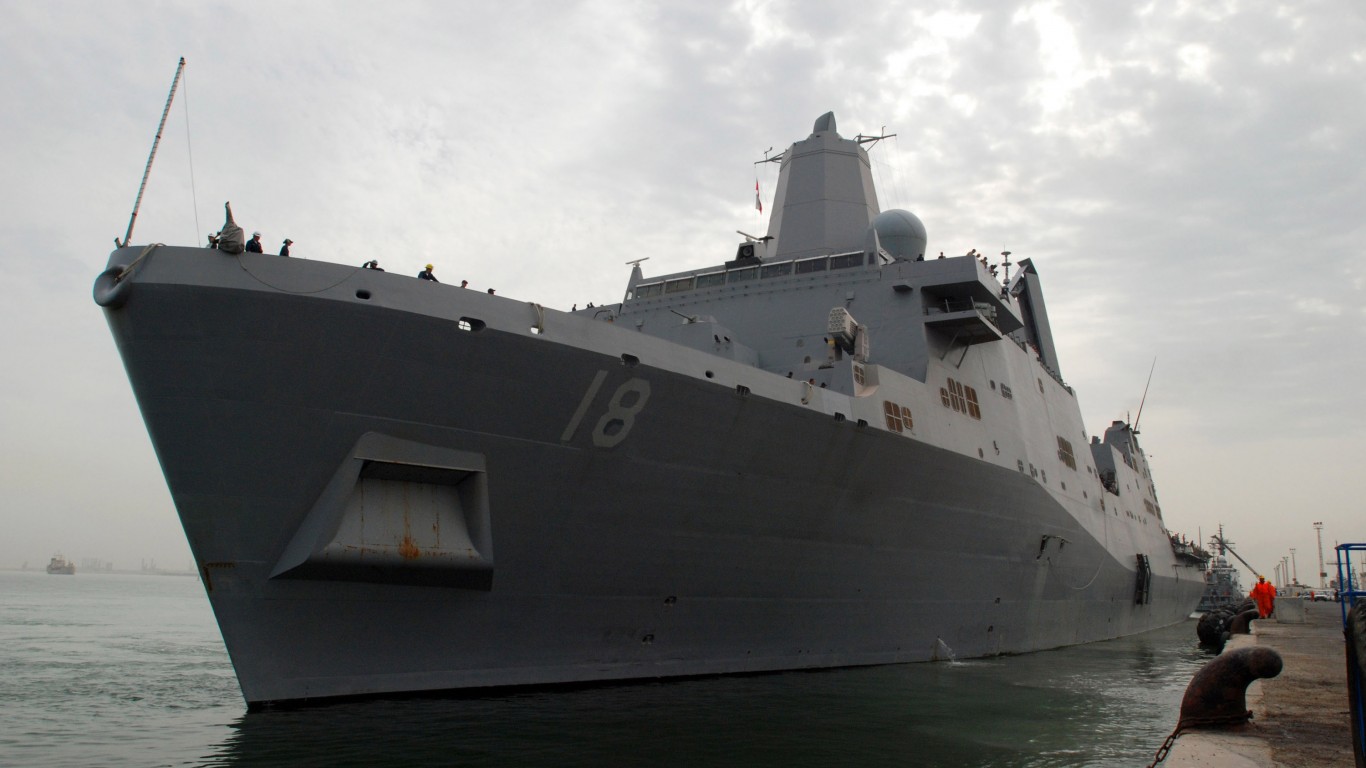
10. Iran
> Military and paramilitary personnel: 650,000
> Military spending, 2020: $15.8 billion (2.2% of GDP)
> Change in military spending, 2011-2020: +10.8%
> Population: 82,913,906
There are an estimated 650,000 active-duty military personnel in Iran. Military members serve in one of two branches — the Islamic Republic of Iran Regular Forces or the Islamic Revolutionary Guard Corps, which the U.S. designated a terrorist organization in April 2019.
Iran’s military arms and equipment are primarily supplied by China and Russia, though some U.S. equipment acquired before diplomatic ties were broken during the country’s Islamic Revolution in 1979 is still in use. Iran spends $15.8 billion on its military annually, or 2.2% of its GDP. Since 2011, the country has increased its military spending by 10.8%. Iran is estimated to have 1,000 military personnel stationed in Syria.
[in-text-ad]
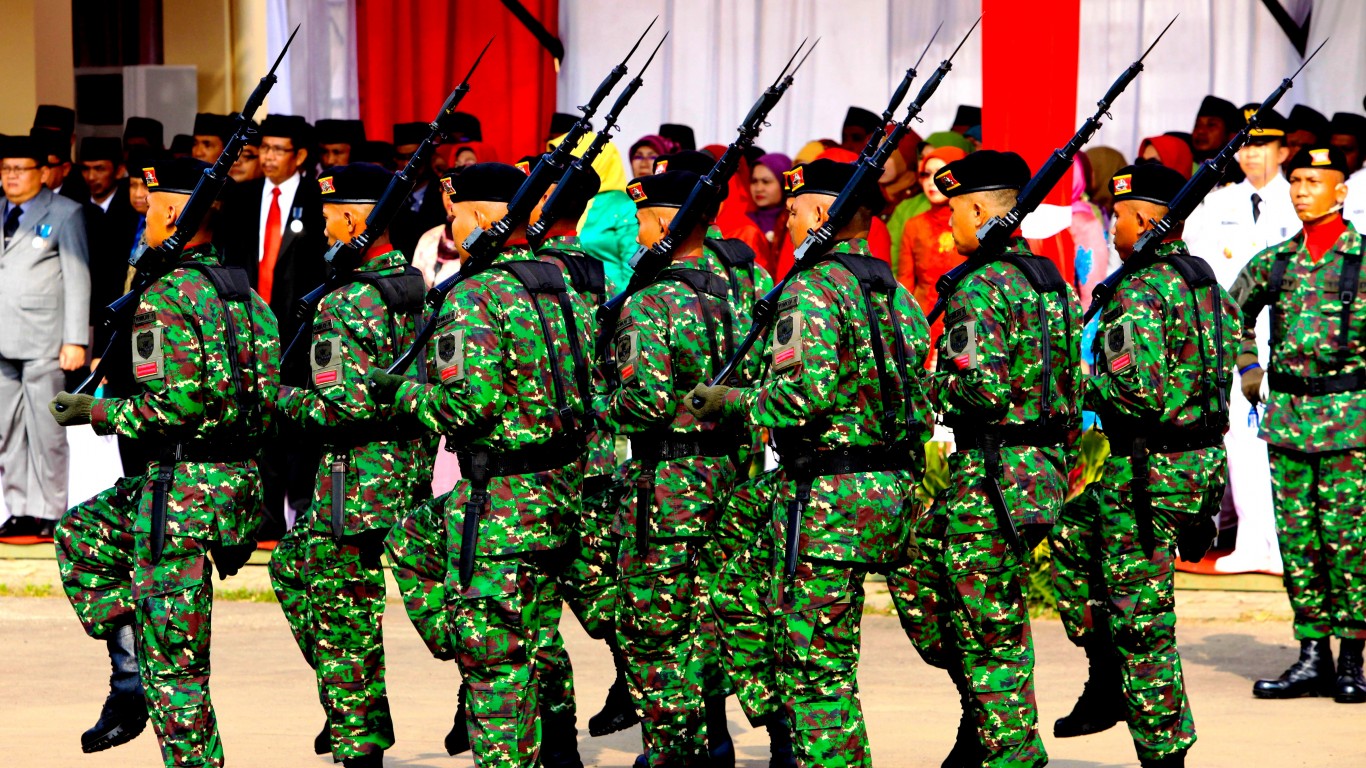
9. Indonesia
> Military and paramilitary personnel: 675,500
> Military spending, 2020: $9.4 billion (0.9% of GDP)
> Change in military spending, 2011-2020: +60.9%
> Population: 270,625,568
The Indonesian National Armed Forces, as well as paramilitary groups across the island nation in Southeast Asia, count 675,500 people among its ranks. In addition to the army, navy, marines, and air force, Indonesian President Joko Widodo recently created the Komponen Cadangan, or KOMCAD, which will serve as a reserve branch of the military.
The country spent $9.4 billion on defense in 2020, or about 0.9% of its GDP. Though it has its own burgeoning defense industry, Indonesia’s military arms and equipment have been largely supplied by China, Germany, Russia, South Korea, the U.K., and the United States.
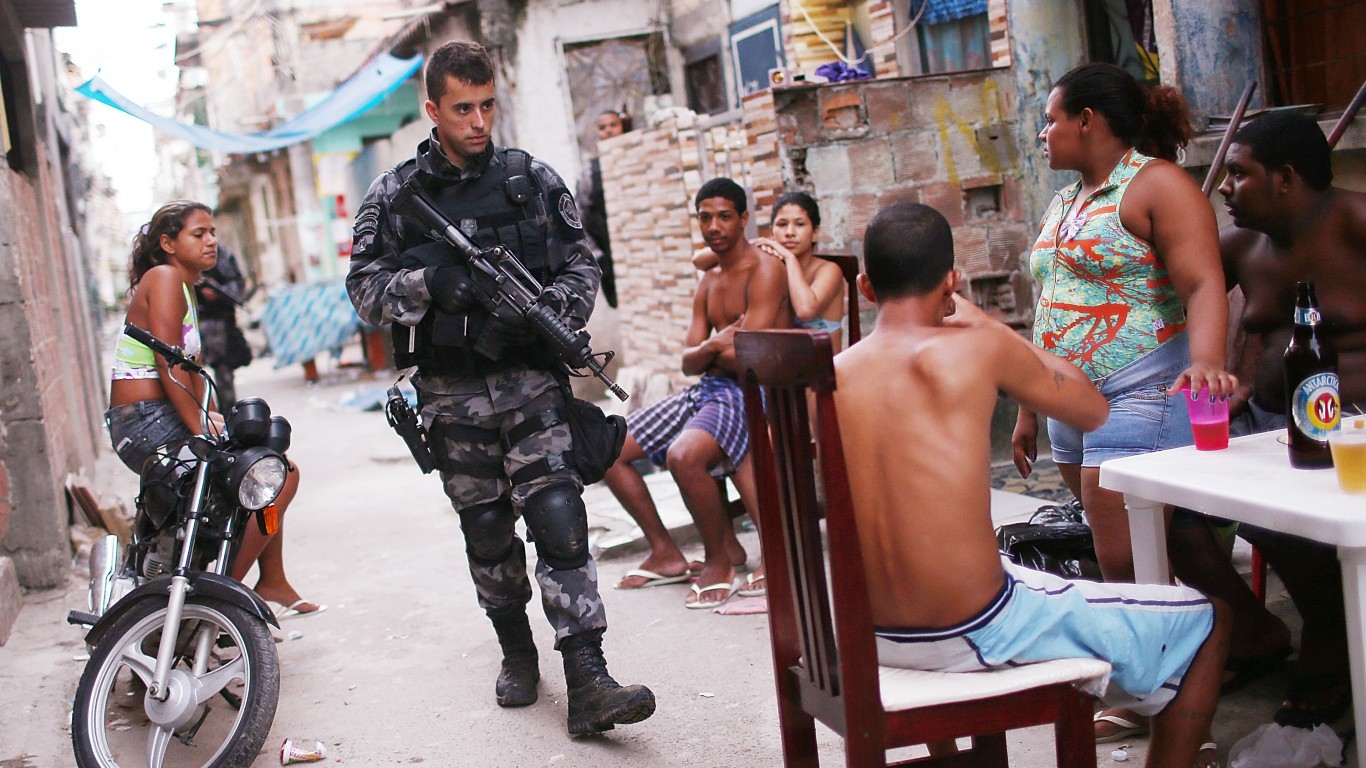
8. Brazil
> Military and paramilitary personnel: 761,500
> Military spending, 2020: $19.7 billion (1.4% of GDP)
> Change in military spending, 2011-2020: -46.6%
> Population: 211,049,527
Brazil’s military is the largest in South America and eighth largest worldwide. The army is the country’s largest military branch, with about 215,000 personnel, followed by the navy with 75,000, and the air force with 70,000. Paramilitary groups account for the remaining personnel in the country. Brazil’s military functions primarily as a border security enforcement entity in the region.
Earlier this year, Brazilian president Jair Bolsonaro fired his country’s defense minister. The ousting was followed by the resignation of the three commanders of Brazil’s armed forces, exposing a potential rift between the executive branch and the military. A former army officer himself, Bolsonaro is a polarizing figure with a promarket and socially conservative agenda.
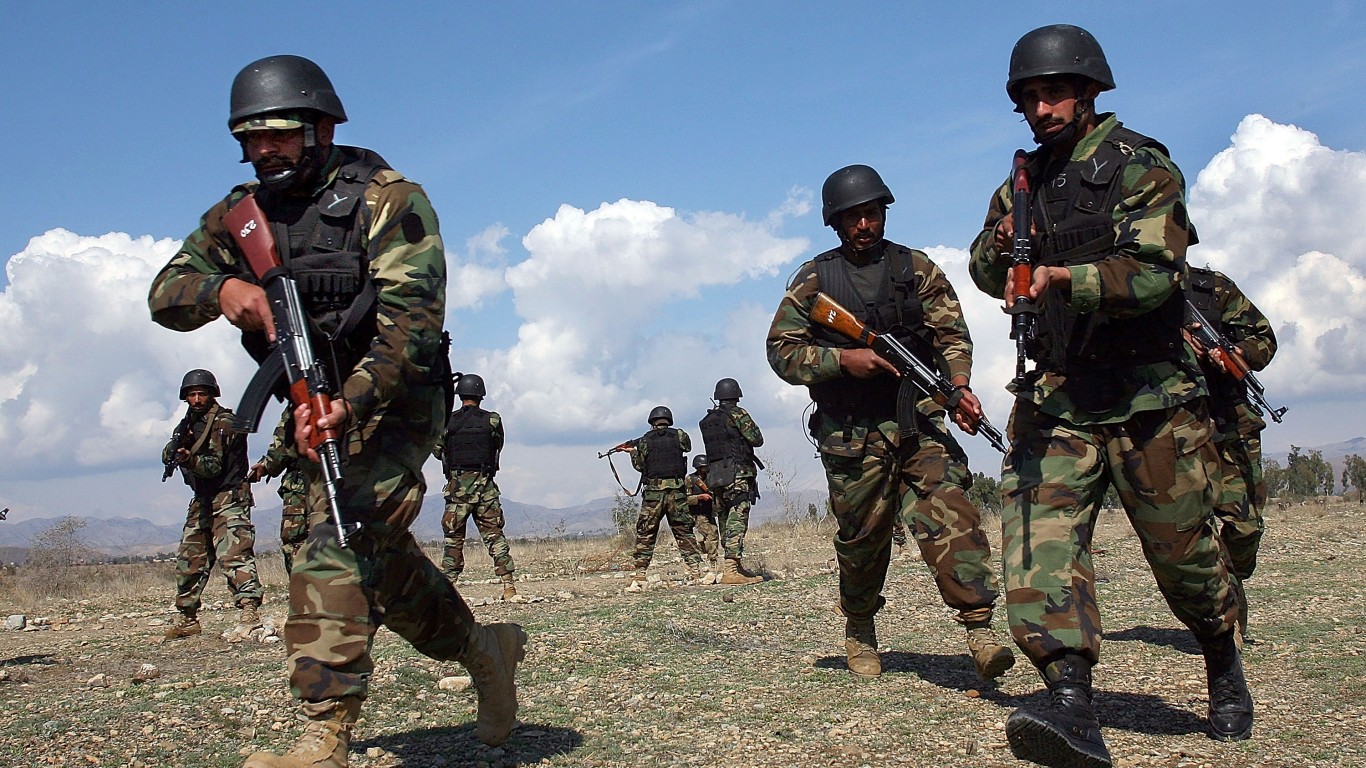
7. Egypt
> Military and paramilitary personnel: 835,500
> Military spending, 2020: $4.5 billion (1.2% of GDP)
> Change in military spending, 2011-2020: +0.9%
> Population: 100,388,073
> Military and paramilitary personnel: 944,800
> Military spending, 2020: $10.4 billion (4.0% of GDP)
> Change in military spending, 2011-2020: +49.2%
> Population: 216,565,318
There are an estimated 835,500 people enlisted in Egypt’s military and paramilitary groups. Since a 2011 revolution that ousted the country’s longtime leader, President ḤosnÄ« MubÄrak, Egypt’s military has been engaged in conflict with insurgency and terrorist forces — including the Islamic State — in the northern half the Sinai Peninsula. Egypt’s military is also involved in civilian enterprises such as managing infrastructure projects, running banks, and consumer and industrial goods production.
Egypt’s military spending of $4.5 billion in 2020 is about the same as what it was in 2011. However, adjusting for inflation, the country’s military spending is effectively about 6.9% lower than it was in 2011.
strong>6. Pakistan (sam) done f/c MA
There are just under 1 million active-duty personnel in Pakistan, more than in all but five other countries worldwide. These forces include the army, navy, and air force, as well paramilitary groups like the Army Reserve, the Frontier Corps, and the Pakistan Rangers.
Pakistan spent over $10 billion on its military in 2020, or 4.0% of its GDP. Like its regional rival India, a country that Pakistan has been locked in a territorial dispute with, Pakistan has greatly increased its military spending in recent years. Between 2011 and 2020, the country’s defense budget has climbed by 49.2%. India’s budget increased by 46.9% over the same period. Also like India, Pakistan has nuclear weapons.
[in-text-ad-2]

5. United States
> Military and paramilitary personnel: 1,379,800
> Military spending, 2020: $778.2 billion (3.7% of GDP)
> Change in military spending, 2011-2020: +3.4%
> Population: 328,239,523
The United States has far and away the largest military budget of any country. At $778.2 billion, U.S. military spending is more than triple China’s military budget, which is the second largest in the world. When it comes to manpower, however, the U.S. is not the global leader. There are about 1.4 million active-duty military personnel in the United States, fifth most in the world. Adjusting for population, however, there are 4.2 military men and women for every 1,000 people, more than double the comparable ratio in India and China, the two countries with the world’s largest militaries.
The U.S. military has a massive global footprint, and many active-duty personnel are deployed overseas. There are thousands of American troops stationed at bases in Asia, Africa, Europe, and South America.

4. Russia
> Military and paramilitary personnel: 1,454,000
> Military spending, 2020: $61.7 billion (4.3% of GDP)
> Change in military spending, 2011-2020: -12.1%
> Population: 144,373,535
There are an estimated 1.5 million military and paramilitary service members in Russia. These men and women serve across multiple branches, including Ground Troops, Airborne Troops, Navy, Aerospace Forces, and Strategic Rocket Forces. Russia’s military spending of $61.7 billion ranks as the fourth highest in the world, trailing the U.S., China, and India.
Historically, Russia has posed a military threat to the U.S. and other Western powers. In recent decades, however, its influence has waned — though it remains a nuclear power. Russia currently has as many as 30,000 troops stationed in Ukraine, where it annexed the Crimea in 2014. There are also estimated to be 2,000 Syrian fighters in Libya that are backed by Russia.
[in-text-ad]

3. North Korea
> Military and paramilitary personnel: 1,469,000
> Military spending, 2020: N/A
> Change in military spending, 2011-2020: N/A
> Population: 25,666,161
North Korea is a nation run by a secretive and totalitarian regime. Home to about 25.7 million people, North Korea maintains strong military capabilities for a country of its size. There are an estimated 1.5 million active duty military personnel in North Korea — or 57 for every 1,000 citizens. Men in North Korea are believed to be required to serve in the military for eight years starting at age 17, and women, for five years.
Largely cut off from the rest of the world, little is known about North Korea’s military budget. Some estimates put the country’s military spending at as much as $4.2 billion in 2019 — equal to a staggering 24% of its GDP. Since demonstrating its possession of nuclear weapons in 2006, North Korea’s status as a global pariah has only been heightened.
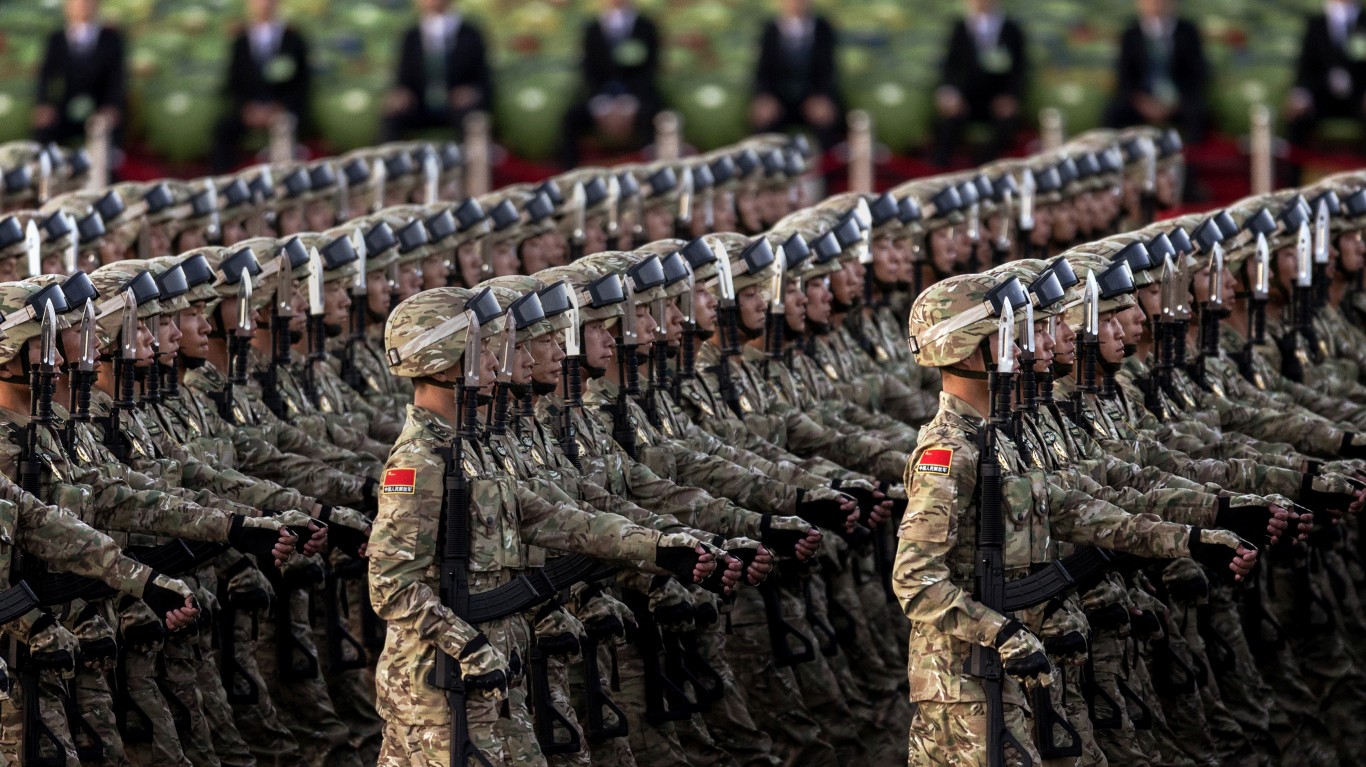
2. China
> Military and paramilitary personnel: 2,695,000
> Military spending, 2020: $252.3 billion (1.7% of GDP)
> Change in military spending, 2011-2020: +101.4%
> Population: 1,397,715,000
China’s military is nearly the largest in the world, with an estimated 2,695,000 active-duty personnel. Estimates of global military powers that do not include paramilitary forces in India rank China as far and away the world’s largest military. China is also the world’s most populous country, and adjusting for population, there are only about 1.9 service members for every 1,000 people, fewer than in many countries on this list. In the United States, for example, there are 4.2 active-duty servicemen and servicewomen per 1,000 residents.
China’s military budget is also nearly the largest in the world. The ascending Asian power spent $252.3 billion on its military in 2020 — more than double its military spending in 2011 and equal to about 1.7% of its total GDP. The U.S. is the only country in the world that spends more on its military than China.

1. India
> Military and paramilitary personnel: 3,026,500
> Military spending, 2020: $72.9 billion (2.9% of GDP)
> Change in military spending, 2011-2020: +46.9%
> Population: 1,366,417,754
India, the world’s second most populous country, is home to the world’s largest military. There are nearly 1.5 million active-duty members of India’s military in the army, navy, air force, and coast guard. There are roughly 1.5 million more paramilitary service members in the country. These groups, which are managed through the Ministry of Home Affairs, include the Assam Rifles, Border Security Force, and the Central Industrial Security Force
India spent $72.9 billion on its military in 2020, or nearly 3% of its GDP. Military investment is a priority in India partially due to its ongoing conflict with Pakistan over Kashmir — the largest and most militarized territorial dispute in the world. That both India and Pakistan are nuclear powers elevates the tensions considerably.
The thought of burdening your family with a financial disaster is most Americans’ nightmare. However, recent studies show that over 100 million Americans still don’t have proper life insurance in the event they pass away.
Life insurance can bring peace of mind – ensuring your loved ones are safeguarded against unforeseen expenses and debts. With premiums often lower than expected and a variety of plans tailored to different life stages and health conditions, securing a policy is more accessible than ever.
A quick, no-obligation quote can provide valuable insight into what’s available and what might best suit your family’s needs. Life insurance is a simple step you can take today to help secure peace of mind for your loved ones tomorrow.
Click here to learn how to get a quote in just a few minutes.
Thank you for reading! Have some feedback for us?
Contact the 24/7 Wall St. editorial team.